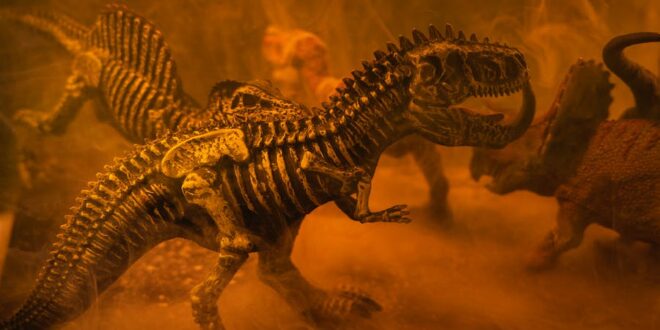A T. rex vs human comparison is a fascinating exploration of nature’s diversity. T rex was one of the largest carnivorous dinosaurs that lived in the late Cretaceous period, 68 million years ago.
It’s one of the most studied dinosaurs and has been featured in multiple science fiction cinemas and games.
The discovery of T. rex skeletons like ‘Sue’ has led to a growing curiosity about how humans would have fared against these beasts.
While there is still much we need to understand about T. rex, our knowledge is sufficient to draw distinctive comparisons to humans.
Similarities Between T. rex And Humans
Although humans and T rex don’t share a common ancestry, the two species have some similarities, including;
Bipedal Locomotion
T. rex was a bipedal dinosaur that walked on two legs. It had powerful hind limbs well adapted for quick and efficient movement. Its forelimbs were short and were probably used to holding prey in close quarters.
Humans are also bipedal, and our skeletal structure has adapted for upright walking on two legs.
Our bipedalism is an adaptation that allows us to use our hands for other productive functions like tool use and lifting objects.
Senses
Both humans and T. rex possess well-developed senses, although the specifics differ. Scientists believe that T. rex has a high sense of smell.
They had large olfactory bulbs in their brains, suggesting a keen sense of smell. They also had large eyes, which provided them with excellent binocular vision that served them well when hunting.
Humans also have well-developed vision and hearing senses. We have eyes with colour vision and depth perception, and our sense of hearing allows us to communicate and perceive sounds in our environment.
While our sense of smell is not as acute as some animals, it plays a role in detecting scents.
Social Behavior
Some palaeontologists believe that T. rex exhibited social behaviours, including living in hierarchical family groups. Their hypothesis is supported by discovering multiple T. rex specimens found nearby.
Similarly, humans are known for their complex social behaviours and the formation of intricate societies. We live in family units, form communities, and have developed languages for communication.
T. rex vs Human: Our Differences
Tyrannosaurus rex and humans are vastly different species with numerous differences. Some of their distinctive characteristics include;
Size and Anatomy
T. rex were gigantic dinosaurs, with an estimated up to 40 feet and a weight ranging from 9 to 15 tons.
It had an enormous head, serrated teeth, powerful jaws, and a robust body. T. rex had relatively small, nonfunctional arms, and its rear legs were adapted for running and hunting.
In contrast, humans are relatively smaller in size. An average adult human is around 5.5 to 6.5 feet and can weigh between 45 and 136 kilograms.
We also have a relatively small head and limbs. Our arms are highly dexterous and can perform an array of tasks.
Diet
Humans are omnivores with a diverse diet that ranges from plant to animal sources. We rely on tools, technology, and social organisation sourcing and preparing our meals.
On the other hand, T. rex were carnivorous predators whose diet consisted of different dinosaurs and large animals. It used its sharp teeth and powerful jaws to capture and consume prey.
Intelligence and communication
T. rexes were reptiles with a tiny brains relative to their body size. Their Intelligence was likely limited compared to modern mammals, including Humans. Their Intelligence was focused on basic survival behaviours such as hunting and feeding.
On the other hand, humans are known for their high Intelligence. We have large and highly developed brains capable of handling complex cognitive tasks like planning and problem-solving.
Researchers believe that T. rex communicated through nonverbal cues and sounds, but their communication system was inferior to humans.
T. rex Dinosaurs Physical Description
The world’s most complete T. rex skeleton is of ‘Sue’, a fossil at the Chicago Field Museum. This fossil has helped scientists to come up with an accurate depiction of what these animals looked like. So, how exactly did T. rex look like?
Body Size
Based on the fossil, T. rex were giant carnivorous reptiles that stood at heights of 15 meters at the hip. Adult T. rexes are estimated to reach 40 feet in length and weigh up to 15 tons.
The reconstructed fossil of a T. rex named ‘Sue’ at the Field Museum discovered in 1990 is longer than a school bus! Palaeontologists believe that there could have been bigger members of the species.
Head
T. rex had a massive head with powerful jaws and large, serrated teeth. Its teeth were adapted for biting and tearing flesh. T. rex had the strongest bite force of about 10,000 psi, allowing it to crush bone.
It also had a binocular vision that allowed it to look ahead and not from the sides, as with most animals.
Arms
These species of dinosaurs had small, seemingly vestigial arms. Each arm had two clawed fingers that were not functionally suited for specialized tasks like grasping or manipulating objects. The exact purpose of these small arms is still debated among palaeontologists.
A popular theory is that T. rex underwent persistent hunting adaptation like humans. According to the hypothesis, early humans evolved into bipedal through selection. This adaptation allowed them to run prey to exhaustion during the day’s heat.
Legs
T. rex had two large, powerful hind limbs adapted for running and hunting. Researchers believe that the massive size of the legs allowed them to cover a lot of ground by simply walking.
However, the working theory is that these beasts could run for speeds of between 12 to 25 miles per hour! Their feet also had giant clawed tows that helped them pin down prey while feeding like birds.
Tail
The T. rex had a long tail, almost half the length of its body. This tail was vital to balance and stability while running and making quick turns. It is also believed that T. res used its tail to fight and defend itself.
Skin
While no skin fossils have been found, researchers believe that T. rex had scaly, reptilian skin, like modern reptiles. Several theories suggest their skin colouration, but all are just speculations.
Would T. rex feed on Humans?
We have all seen a science fiction movie where a dinosaur rains terror and havoc on humans. Science fiction in games and films has painted these giants as man’s ultimate predators, but in reality, would they feed on us?
If humans coexisted with T. rex, it is safe to assume that these giants could prey on us. Since they were carnivores, it is difficult to rule out the possibility of them snacking on us.
However, due to their massive sizes, it would not make sense for adult-sized T. rex to hunt humans. Instead, they would focus on getting larger prey with more calories to offer. According to researchers, the ideal prey size for T. rex ranges between 90 to 100 kilograms.
T. rex Fun Facts
- With a bite force of 8,000 to 12,000 psi, T. rex had the most powerful bite in history. Its powerful jaws allowed it to prey on large animals as it could crush bones.
- Although T. rex was giant, it could run fast. It is estimated that they had a speed of approximately 12 to 25 miles per hour. Such speed, combined with its strength, made it a formidable predator.
- The T. rex had a wide mouth filled with close to 60 strong teeth. It is believed that they maintained their feeding ability by growing new teeth to replace old or damaged ones.
- Palaeontologists believe that T. rex exhibited cannibalism behaviours. Their theory is supported by fossil evidence indicating that some T. rex had bite wounds from teeth that resembled that of their kind.
- Although T. rex were large animals, they had a relatively short lifespan of about 28 years. This short lifespan could have been due to psychological challenges in maintaining a massive body.
At their scale, it might have been more difficult for their bodies to heal from wear and tear, making them more susceptible to injury and diseases.
Another possible explanation could have been rapid changes in climate and ecosystem synonymous with the late Cretaceous period.
Rapid fluctuations in temperature, food availability and other critical environmental factors could have affected their lifespans.
- T. re are believed to have gone extinct around 68 million years ago during the Cretaceous-Paleogene extinction event. This was the event that wiped out all the other non-avian dinosaurs.
Conclusion
The T. rex vs human competition is one that early humans couldn’t stand a chance to win. Save from Intelligence, these giant reptiles outsmarted us in all adaptations, making them the Apex predators of their time.
However, in the modern world, where man has gathered an arsenal of destructive weapons, we could stand a chance. What do you think?
 Being Human
Being Human





